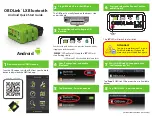
LaMotte TRACER pH PockeTester
TM
1741 Instruction
9
Preparation of Buffers
1. Fill a sample cup with 20 mL of distilled or deionized water.
2. Add one buffer tablet:
pH 4.0
Code 3983A
pH 7.0
Code 3984A
pH 10.0
Code 3985A
3. Use the tablet crusher (0175) to crush the tablet. Stir until the tablet has
disintegrated.
NOTE: Buffers should be prepared fresh daily.
pH Calibration
The TRACER can be calibrated at 1, 2 or 3 points. For the most accurate results
with a two point calibration, calibrate the TRACER with a pH 7 buffer fi rst, then
calibrate with either a pH 4 or pH 10 buffer whichever is closest to the pH value
of the sample to be tested. When performing a three point calibration, calibrate
with the pH 7 buffer fi rst, followed with the pH 4 buffer and then the pH 10
buffer. For the most accurate results, always calibrate at the sample temperature.
1. Place the electrode into a buffer solution (4, 7, or 10 pH) and press the CAL
button. Typically, pH 7 is calibrated fi rst, then 4 or 10, depending on the
measurement range. If readings are going to be made over the entire range,
calibrate with 4, 7 and 10 buffers.
2. The TRACER will automatically recognize the solution and calibrate itself to
that value. The circled number on the display will match the pH of the buffer.
Note that if the buffer is more than 1 pH unit off from the 4, 7, or 10 pH
buffer, the TRACER will assume an error and abort the calibration.
CAL
and
END
will be displayed.
3. During calibration, the pH reading will fl ash on the main display.
4. When calibration is complete, the TRACER will automatically display
END
and return to the pH measurement mode.
5. Rinse the electrode with distilled water.
6. The appropriate circled indicator (4, 7, or 10) will appear on the display
when a calibration has been completed. The calibration will be stored until a
new calibration is performed.
7. For a two- or three-point calibration, repeat Steps 1-5.
8. The meter should be calibrated before each use to obtain the most
accurate results.
9. Always turn the meter off and then on before calibrating to allow suffi cient
time to complete the calibrations during one power cycle. If the meter
auto powers off during calibration the calibrations remain valid, but new
calibrations will turn the circled indicators off.


































